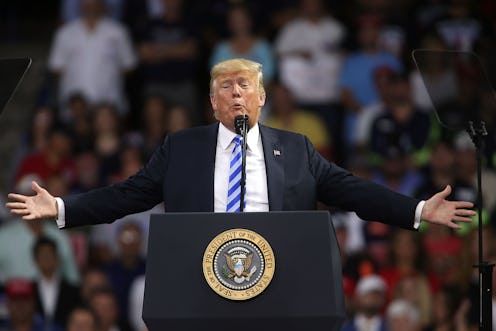News
Trump's Midterm Election Plan Is Super Intense Compared To Presidents Before Him

Gearing up for what promise to be some of the most contentious races in recent decades, President Trump's midterm election campaign plan looks like it will be a lot more intense than those of his predecessors. According to White House officials, Trump is expected to spend at least 40 days on the road, stumping for Republican candidates over the next few months.
President George W. Bush's midterm campaigning schedules were just 33 days in both 2002 and 2006, and President Obama spent only 22 days in 2010, and 36 in 2014, according to CNN. Trump's relatively heavy campaign schedule is likely part of an effort to back up claims he has made that reports of a Democratic sweep — increased voter turnout, vulnerable Republican seats, and polls reporting Democratic preference among voters — are false. In fact, while campaigning at 16 events across eight states just this month, he's claimed a "red wave" is on the rise.
In contrast, a number of historically Republican congressional seats have found themselves threatened by a Democratic "blue wave", this season. Reps. Steve Chabot in Ohio, and Dana Rohrabacher in California, among others, are facing tough races from the left in districts that once sat comfortably Republican. A poll on Wednesday found that Texas Sen. Ted Cruz's Democratic opponent, Rep. Beto O'Rourke, is just 4 points behind, running on a campaign that boasts no corporate PAC donations.
With the exception of the 2002 elections, midterms typically result in a loss of congressional seats for the party in power. In 2002, with the country at the start of the Iraq War, President Bush found himself riding a wave of popularity that put his approval rating at 65% before the midterms. By 2006, however, Bush had become a liability to a beleaguered Republican party, and even personally took responsibility for the loss of 28 seats in the House of Representatives and 5 in the Senate
For President Obama, reports showed that his low favorability ratings in 2010 and also in 2014 were actually bad for Democratic candidates trying to hold on to their seats. For that reason, Obama chose to skip states like Arkansas and Alaska in 2014, and focus instead on bluer states where he could make more of a dent. Democrats still lost 13 House seats and 9 Senate seats in 2014.
Since leaving office, Obama has kept a low profile in the political arena, but he'll be hitting the road again for the 2018 midterms. On August 1, he released a list of 81 Democratic endorsements — all in states that had already held primaries — and hinted there would be more to come. He is expected to begin stumping in September, and will apparently avoid any direct interaction with Trump on the campaign trail. Right now it's not clear exactly where Obama will make appearances, but it's speculated he will focus on tight races in Pennsylvania, Ohio, and Florida.
Trump has hovered around a 41% favorability rating for months, and if history is any indicator, the "red wave" he is predicting is probably not on the horizon. Even so, he doesn't appear to be letting up on his enthusiasm for the midterms, given his hectic, upcoming campaign schedule. "A blue wave in November means open borders, which means massive crime," he said at a rally in West Virginia on Tuesday. "A red wave means safety and strength, that's what it is." He continued, "We're gonna be out a lot. We're going to a lot of different states."